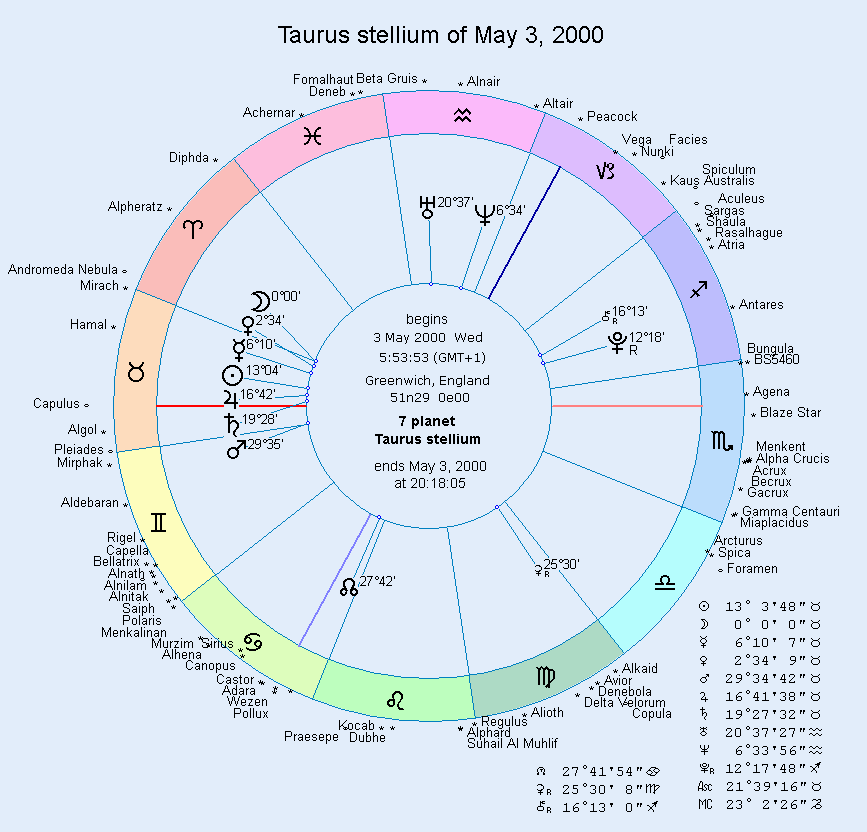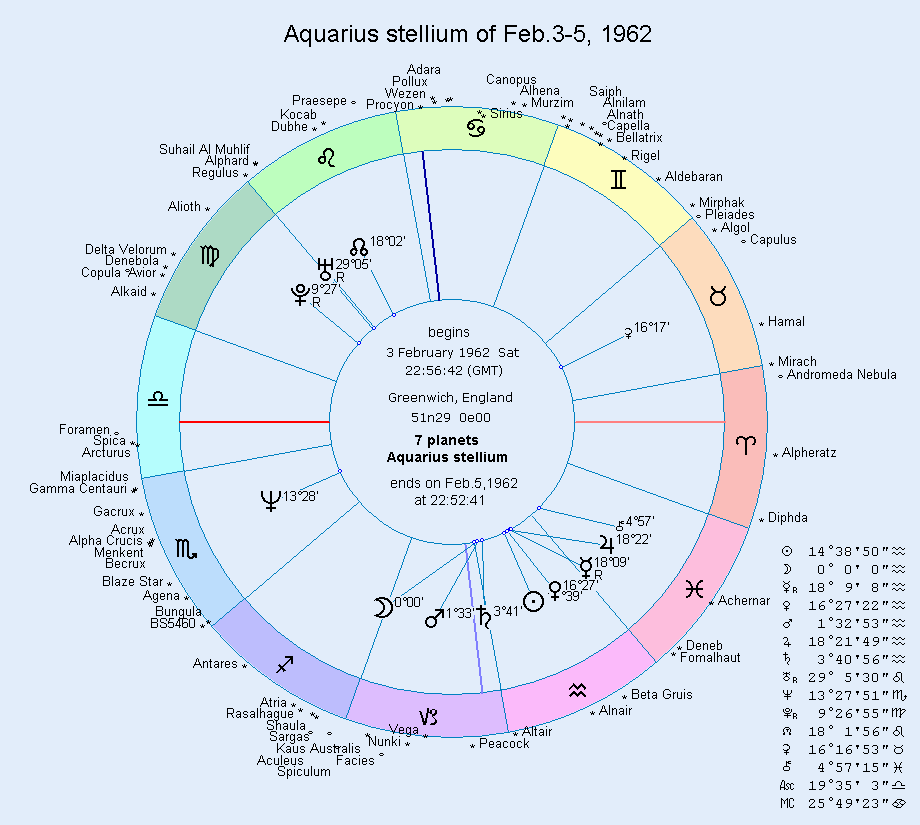|
This is an extremely significant stellium, second only to the Aquarian stellium of February 3-4th, 1962, and it has apparently been
overlooked by many, including this author.
All seven traditional planets from Sun to Saturn are in Taurus on that day for a period of 14 hours and 24 minutes as compared to just under two days for the Aquarian stellium of 1962. If the Aquarian stellium of 1962 officially ushered in the Aquarian Age, then what does this shorter Taurus stellium some 38 years later portend? Aquarius is associated with truth, freedom. progress, and brotherhood, whereas Taurus is associated with money, wealth, possessions, and ownership. These two signs are in square or 90° aspect and represent conflicting values or ideals. Both charts(included) show an overwhelming predominance of planets in the fixed signs. Only Pluto is mutable. The Taurus chart is even more fixed if we consider the rising sign which is also in Taurus when the stellium began.  In both charts, the relationship between the stelliums and the outer planets is quite interesting. In the Taurus chart Uranus and Neptune are in Aquarius or tenth house aspect(by sign) to the main grouping indicating an ambitious humanitarianism, especially with Uranus in its own sign. Neptune in Aquarius is mystical or illusory truth. The individual or corporation with this chart will do everything it possibly can materially and financially to bring about a utopia or brotherhood based on both science and mysticism. Pluto in Sagittarius in the 8th house is deep and intense religious transformation. Capricorn on the MC signifies governance and rule. Sounds much like the New World Order which which is using economics and religious sway to establish its idea of universal brotherhood. Could it be that there are two overlapping Ages going on? The first is the Aquarian Age which had its earliest roots in the Rennaisance, Colonialism, America, The Industrial Revolution, and the Space Age(1962). The second is the overlapping Taurean Age of the Illuminati(May 1st,1776), with its Federal Reserve(Dec.23rd,1913), and the global economy(May 2000?). The two Age timelines are obviously very different or even at cross purposes. It would be interesting indeed to put together two individuals with such diverging charts to see what the effects would be. There would be immediate and long-term conflict as all the Taurus planets would square the Aquarius planets. Even the outer planets are in challenging aspect. Then there is the age difference. The Aquarian individual is would be 57(as of 2019) whereas the Taurus individual would only be 19. So the Aquarius would have the upper hand in terms of age or experience as well as representing the 10th house of power or dominance for Taurus. Taurus, with its two Aquarian planets, would understand or even complete the Aquarius in some way, but will do so only in its own way and for its own purposes. The two could not be more set in their ways. This personal comparison, of course, has its global connotations or implications.
There is even a book entitled "5/5/2000 Ice: The Ultimate Disaster" by Richard W. Noone first published in the early 1970's claiming that the ice build-up over 6000 years at the Antarctic, along with the critical planetary alignment in early May 2000, may trigger a pole shift, something which obviously did not happen. The idea, however, was plausible and well-researched and may still have merit. Why is it the earth signs, especially Taurus and Capricorn seem to get such a bad rap in our world, while the air signs, especially Libra and Aquarius, seem to be the saviours? This depends largely on the planets involved. It is true that the Sun is more harmonious or positive in air than it it is in earth but it is also true that the Moon is better in earth(or water) than it is in air(or fire). This is based on the rulerships or dignities. Also there is the question of the ideal chart. Just because one sign is so emphasized does not make it a good thing. It's special, but not necessarily positive. In fact, it is extreme or highly unbalanced. Both charts are extreme in their own way. All that earth can be very negative or selfish, especially the Sun, Mars, or Jupiter, and all that air can be weird or unrealistic, especially Moon, Venus, and Saturn. An ideal or balanced chart contains all the signs, elements, modes, and polarities. So while these 7-planet stellium charts of the inner planets are extremely rare and unusual, and mark momentous epochs or cycles, they do not necessarily bode positive times ahead, but often quite the opposite. Perhaps far more positive is a line up of all the planets in their home or traditional signs of rulership. |
back to home
